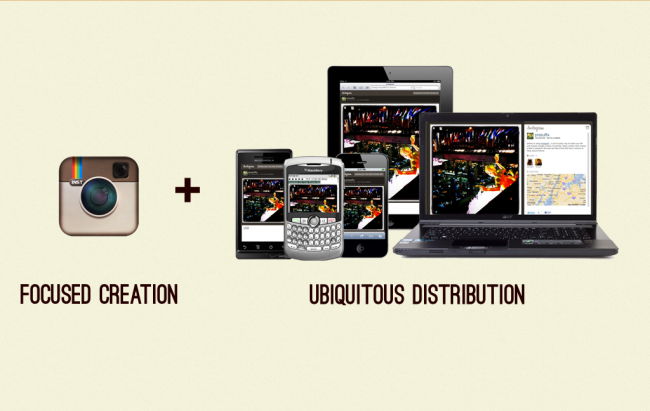Focused Creation. Ubiquitous Distribution.
So I read a load of shit yesterday. “Who needs the Web?” asks the New York Times after Instagram got bought by Facebook for a cool billion dollars.
Instagram needs the web. Path needs the web. Apps need the web. Fuck it, we all need the web.
Just because a successful product began its life as something other a website doesn’t mean the web is rendered obsolete all of a sudden. These things happen now that mobile has matured and companies aren’t simply translating their existing web experiences into mobile apps. Native mobile platforms are now a perfectly viable starting point for new products.
Focused Creation
So let’s make a native camera app. In order to make a photo app, we kind of need to have access to the device’s camera and photo gallery. You can’t do that through mobile browsers (yet*). We’ll whip up our app, add some filters, add some edit modes, bedazzle the shit out of it, and put it in the App Store.
And then we wait. It’s only a matter of time before the users come flooding in. The users arrive and have some fun making some photos. But then what?
Oh yeah! The whole point of creating something is to share it. (Well, unless you created an intricate gold sculpture in secret for 14 years). Ok then, what are our sharing our options? We could have our users do a few things:
- Keep it to themselves. Ah yes, your users’ very own anti-social network. This is like taking pictures with a kickass 35mm camera then not bothering to develop the film.
- Shove their phones in people’s faces. This is like carrying a photo in your wallet and only taking it out to show off to your bar buddies. It can make you look like a crazy person.
- Share with the app’s user base. This is like putting your photos in a photo album and busting it out when family comes to town. Only special people get to see what you’ve created.
- Share it on the web. This is like sharing your photos with billions of people. Because that’s exactly what you’re doing.
Ubiquitous distribution
You’d be a fool to not take advantage of the tremendous distribution platform that is the web. Instagram wouldn’t be the runaway success it is if they kept all the hipster photo goodness locked within its iPhone walls.
Everyone wasn’t invited to the party as far as Instagram’s photo creation was concerned (of course up until last week Instagram was an iPhone-only app), but thanks to the web everyone got to view the output. On social networks everyone could see how hip these photos were, but not everyone had the opportunity to create them. That added to the mystique and the hype. I personally think they played their cards right in that marketing game.
There You Have It
Native apps will never be able to claim complete ubiquity, however the web is slowly becoming a robust creation platform in its own right. Chew on that, but don’t go thinking this is an apples-to-apples comparison, because it ain’t. The power of the web is its ubiquity, and that’s something worth celebrating.
Focused creation. Ubiquitous distribution. Win. Win.

9 Comments
Joe McCann
If I could slow clap this, I would slow clap the shit out of this. Spot on, Brad. Sensationalist articles like the one the NY Times released miss the point entirely and are hopping on the linkbait bandwagon of the FB acquisition of Instagram.
To execute successfully in the mobile space, the web *must* be an integral part. Period. End of discussion.
Derek Pennycuff
The argument is akin to “Who needs blogs? I’ve got a copy of Microsoft Word.” It’s ironic to me that traditional media producers tend to be the last to realize that the web is a publishing/distribution medium. We could put photos online before Instagram. We could put text online before blogs. The web is a tried and true distribution channel that can be drag & dropped into any business model. This frees you to focus on other things. I’m not saying it’s good enough to provide a cookie cutter experience on the web side of such a business model. But you can spend a lot more time tweaking the user experience at ever level when you don’t have to reinvent HTTP from scratch.
Joe Snell
YES!
Tim Klapdor
Great article! I think this ubiquitous/focused paradigm is the shift that old media have been dreading. Your diagram shows creation being focused – but I think you could also flip it to illustrate consumption. The flow of ubiquitous content down to focused consumption using an app, something like Flipboard or Zite.
Tim
Whatever point you were trying to make is lost in your petulant, adolescent writing.
“Fuck it, we all need the web.”
Sounds like a line out of Idiocracy.
Tim Murtaugh
Idiocracy was a good movie.
Thelonious Funk
Broke my 30 year streak of not knowing what the definition of “petulant” is
karl
Errr “Just because a successful product began its life as something other a website doesn’t mean the web is rendered obsolete all of a sudden.”
There is a simple answer to that. Instagram was not using morse or pigeons to send their photos.
The Web is HTTP+URI.
HTML+CSS+JS are (just) formats. Don’t get me wrong, awesome formats for structure, presentation and interactions enabling a lot of things, but that is missing the point of what is the Web.
McShefferty
Great article! Was amazed how far the NYT article managed to miss the point. Seemed that they just wanted to include the sensationalist line “Who needs the web?” and worked backwards from there. The web is changing and evolving all the time. As new ideas and technologies come along they will harness it in a novel ways.
Comments are closed for this post. If you've got something to add, feel free to reach out on Twitter.